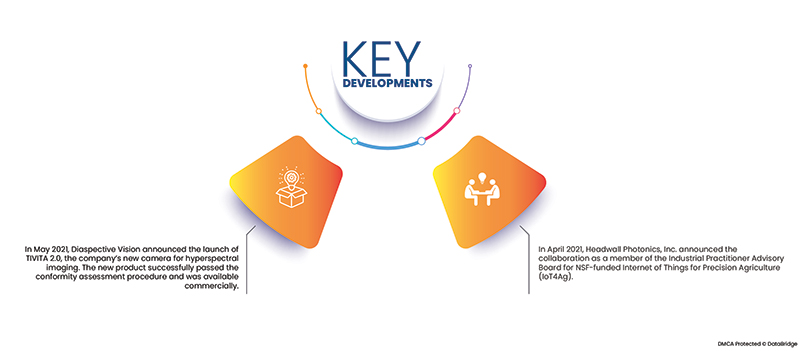In October 2021, Kuva Space, Finland-based space-borne hyperspectral imaging and AI solutions provider raised EUR 4.2 million to fund its campaign to establish a constellation of commercial hyperspectral cubesats. With eh funding, the company plans to develop a constellation of six-unit cubesats to gather imagery in the 400 to 1,100-nanometer band. The company maintains the goal of assisting organizations working to prevent the destruction of biodiversity and ecosystems
Access Full Report @ https://www.databridgemarketresearch.com/zh/reports/global-hyperspectral-imaging-systems-market
The global hyperspectral imaging systems market is expected to reach USD 6,016.04 million by 2028 from USD 1,728.59 million in 2020, growing with a healthy CAGR of 17.6% in the forecast period of 2021 to 2028. The major factors driving the growth of the hyperspectral imaging systems market are increasing government investments in hyperspectral satellite imaging, surging utilization of airborne hyperspectral imaging solutions, and rising use of hyperspectral imaging for the agriculture sector. Surging advancements in hyperspectral imaging for remote sensing is creating opportunities for market growth.

Surging utilization of airborne hyperspectral imaging solutions across the globe will drive the market's growth rate
Hyperspectral imaging systems are capable of acquiring imagery in hundreds of narrow, contiguous spectral bands, which facilitates fine discrimination between different features on the Earth's surface. When incorporated on a moving platform like a satellite, the hyperspectral imaging system can gather emitted radiations from the earth's surface. This technology improves the ability of the satellite to identify unique trends in land and atmospheric data sets. Thus, the numerous application of HSI incorporated satellites such as competitive advantage to predict fires, protect infrastructure, strengthen intelligence, enhance security, mitigate risk, among others is expected to drive the investments in the hyperspectral imaging systems market.
Report Scope and Market Segmentation
|
Report Metric
|
Details
|
|
Forecast Period
|
2021 to 2028
|
|
Base Year
|
2020
|
|
Historic Years
|
2019 (Customizable to 2013 - 2018)
|
|
Quantitative Units
|
Revenue in USD Million, Volumes in Units, Pricing in USD
|
|
Segments Covered
|
Product (Cameras and Accessories), Scanning Techniques (Spatial Scanning, Spectral Scanning, Non-Scanning and Spatiospectral Scanning), Range (Less than 400 Nm, 400 Nm to 1700 Nm and More than 1700 Nm), Technology (Pushbroom (Line Scanning), Snapshot (Single Shot), Whiskbroom (Point Scanning) and Others), Application (Civil Engineering, Military Surveillance, Remote Sensing, Agriculture, Mining/Mineral Mapping, Environmental Monitoring, Life Sciences and Medical Diagnostics, Machine Vision and Optical Sorting, Food Processing, Mineralogy and Other Applications)
|
|
Countries Covered
|
U.S., Canada and Mexico in North America, Germany, France, U.K., Netherlands, Switzerland, Belgium, Russia, Italy, Spain, Turkey, Rest of Europe in Europe, China, Japan, India, South Korea, Singapore, Malaysia, Australia, Thailand, Indonesia, Philippines, Rest of Asia-Pacific (APAC) in the Asia-Pacific (APAC), Saudi Arabia, U.A.E, South Africa, Egypt, Israel, Rest of Middle East and Africa (MEA) as a part of Middle East and Africa (MEA), Brazil, Argentina and Rest of South America as part of South America.
|
|
Market Players Covered
|
Imec VZW (Belgium), Corning Incorporated (U.S.), HORIBA, Ltd (Japan), Hamamatsu Photonics K.K. (Japan), Thorlabs, Inc. (U.S.), BaySpec, Inc. (U.S.), Brandywine Photonics LLC (U.S.), ChemImage Corporation (U.S.), Cubert GmbH (Germany), CytoViva, Inc. (U.S.), Diaspective Vision (Germany), Headwall Photonics, Inc. (U.S.), Hinalea Imaging (U.S.), HyperMed Imaging, Inc. (U.S.), Inno-Spec GmbH (Germany), LLA Instruments GmbH & Co. KG (Germany), Norsk Electro Optik AS (Canada), Photon Etc. Inc. (Norway), Physical Sciences Inc. (U.S.), Raptor Photonics (U.K.), Resonon Inc. (U.S.), SPECIM (Finland), SPECTRAL IMAGING LTD. (Finland), STEMMER IMAGING AG (Germany), Surface Optics Corporation (U.S.), Teledyne Digital Imaging Inc. (Canada), Telops (Canada), XIMEA Group (Germany) among others.
|
|
Data Points Covered in the Report
|
In addition to the market insights such as market value, growth rate, market segments, geographical coverage, market players, and market scenario, the market report curated by the Data Bridge Market Research team includes in-depth expert analysis, import/export analysis, pricing analysis, production consumption analysis, and pestle analysis.
|
Segment Analysis:
The global hyperspectral imaging systems market is segmented into eight notable segments which are based on the product, scanning techniques, range, technology, speed, number of tap, and application.
- On the basis of product, the global hyperspectral imaging systems market has been segmented into cameras and accessories. In 2021, the cameras segment is expected to dominate the global hyperspectral imaging systems market with a 66.71% market share as the camera is the major product in the hyperspectral imaging system and the increasing adoption of hyperspectral technology for military and industrial applications contributing to the growth of the segment in the market.
- On the basis of scanning techniques, the global hyperspectral imaging systems market has been segmented into spatial scanning, spectral scanning, non-scanning, and spatiospectral scanning. In 2021, the spatial scanning segment is expected to dominate the market with a 43.74% market share as spatial scanning is one of the main methods used for hyperspectral data acquisition and provides high spectral resolution over a wide range of the spectrum. Spatial scanning is the reason for the usage of hyperspectral scanning which fuels the adoption and the growth of the segment.
- On the basis of range, the global hyperspectral imaging systems market has been segmented into less than 400 nm, 400 nm to 1700 nm, and more than 1700 nm. In 2021, the 400 nm to 1700 nm segment is expected to dominate the market with a 53.10% market share as the 400 nm to 1700 nm range is the most commonly used range for hyperspectral imaging in applications such as detection of contaminants in food, medical diagnostics, military surveillance, plastic recycling, and others.
- On the basis of technology, the global hyperspectral imaging systems market has been segmented into pushbroom (line scanning), snapshot (single shot), whiskbroom (point scanning), and others. In 2021, pushbroom (line scanning) is expected to dominate the market with a 40.07% market share as pushbroom technology is faster than any other, gathers more light, they have a better radiometric and spatial resolution, and is the most popular hyperspectral imaging approach, which fuels the adoption of pushbroom technology in the hyperspectral imaging system market.
The pushbroom (line scanning) will dominate the technology segment of the functional mushroom market
The pushbroom (line scanning) will emerge as the dominating segment under technology in 2021 with approximately 40% market share. This is because of the growing number of infrastructural development activities and store based retailers in the market especially in the developing economies. Further, growth and expansion of the semiconductors industry all around the globe will further bolster the growth of this segment.
- On the basis of application, the global hyperspectral imaging systems market has been segmented into remote sensing, military surveillance, machine vision & optical sorting, life sciences & medical diagnostics, agriculture, food processing, environmental monitoring, mining/mineral mapping, minerology, civil engineering, and other applications. All of these segments are further sub-segmented by product into cameras and accessories. In 2021, remote sensing is expected to dominate the market with a 20.0% market share as hyperspectral imaging in many applications such as agriculture, mineral exploration, environmental monitoring, and others for remote sensing. Remote sensing in hyperspectral imaging address issues in fields that are not visible to the human eye.
The remote sensing segment will dominate the application segment of the functional mushroom market
The remote sensing segment will emerge as the dominating segment under application segment in 2021. This is because of the growing number of sample collection procedures for various research purposes application areas for the hyperspectral imaging systems in the market especially in the developing economies. Further, growth and expansion of research development services on a global scale will further bolster the growth of this segment.
- On the basis of speed, the global hyperspectral imaging systems market has been segmented into upto 20 MHz, 20 MHz to 40 MHz, and more than 40 MHz.
- On the basis of the number of taps, the global hyperspectral imaging systems market has been segmented into one tap and two taps.
Major Players
Data Bridge Market Research recognizes the following companies as the market players in hyperspectral imaging systems market: Imec VZW (Belgium), Corning Incorporated (U.S.), HORIBA, Ltd (Japan), Hamamatsu Photonics K.K. (Japan), Thorlabs, Inc. (U.S.), BaySpec, Inc. (U.S.), Brandywine Photonics LLC (U.S.), ChemImage Corporation (U.S.), Cubert GmbH (Germany), CytoViva, Inc. (U.S.), Diaspective Vision (Germany), Headwall Photonics, Inc. (U.S.), Hinalea Imaging (U.S.), STEMMER IMAGING AG (Germany), Surface Optics Corporation (U.S.), Teledyne Digital Imaging Inc. (Canada), Telops (Canada) and XIMEA Group (Germany).

Market Development
- In May 2021, Diaspective Vision announced the launch of TIVITA 2.0, the company's new camera for hyperspectral imaging. The new product successfully passed the conformity assessment procedure and was available commercially. Some of the features of the new product include non-contact, non-invasive imaging without the risk of contamination, free from ionizing radiation, free from contrast agents, among others.
- In April 2021, Headwall Photonics, Inc. announced the collaboration as a member of the Industrial Practitioner Advisory Board for NSF-funded Internet of Things for Precision Agriculture (IoT4Ag). NSF Engineering Research Center staff utilized Headwall's hyperspectral sensors by integrating them onto unmanned aerial vehicle (UAV) systems to create data-driven models to capture and analyze plant physiology, soil properties, management, and environmental variations. This enhanced the company's presence in the agricultural technology community.
Regional Analysis
Geographically, the countries covered in the hyperspectral imaging systems market report are U.S., Canada and Mexico in North America, Germany, France, U.K., Netherlands, Switzerland, Belgium, Russia, Italy, Spain, Turkey, Rest of Europe in Europe, China, Japan, India, South Korea, Singapore, Malaysia, Australia, Thailand, Indonesia, Philippines, Rest of Asia-Pacific (APAC) in the Asia-Pacific (APAC), Saudi Arabia, U.A.E, South Africa, Egypt, Israel, Rest of Middle East and Africa (MEA) as a part of Middle East and Africa (MEA), Brazil, Argentina and Rest of South America as part of South America.
As per Data Bridge Market Research analysis:
North America is the dominant region in hyperspectral imaging systems market during the forecast period 2021 - 2028
North America had the largest market share due to its robust healthcare infrastructure, high healthcare spending, and rising use of cutting-edge technologies. According to research America's figures, the United States spent roughly USD 171.8 billion on medical and healthcare R&D. The expansion of the medical device market in this region is also accelerated by the focus on healthcare and related measures, such as the Patient Protection and Affordable Care Act. This element is anticipated to be positive for the market soon.
Asia-Pacific is estimated to be the fastest growing region in hyperspectral imaging systems market the forecast period 2021 - 2028
Asia-Pacific has been predicted to experience the quickest growth throughout the forecast period due to the presence of a sizable patient base, rising healthcare awareness, government support for R&D, and planned research programs. The necessity for hyperspectral imaging in research projects, remote sensing applications, and mining explorations is anticipated to expand.
COVID-19 Impact
The COVID-19 outbreak has affected trade and economic activity all across the world. The global market for hyperspectral imaging systems is anticipated to see a short-term impact from the epidemic. Production and manufacturing were significantly impacted as a result of several nations around the world declaring widespread lockdowns and the temporary shutdown of a variety of businesses. Trade obstacles further exacerbated the demand-supply mismatch. Surface Optics Corporation (US), a company that sells hyperspectral imaging devices, has halted all non-essential visits and activities until the COVID-19 epidemic has been contained. Nevertheless, a lot of these businesses are still operating remotely. Production and manufacturing have already started in key sectors like healthcare, food, agriculture, and defence.
For more detailed information about the hyperspectral imaging systems on market report, click here – https://www.databridgemarketresearch.com/zh/reports/global-hyperspectral-imaging-systems-market












